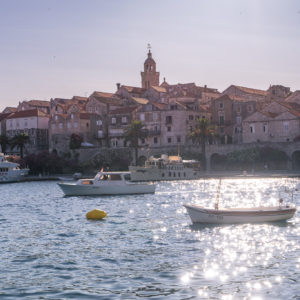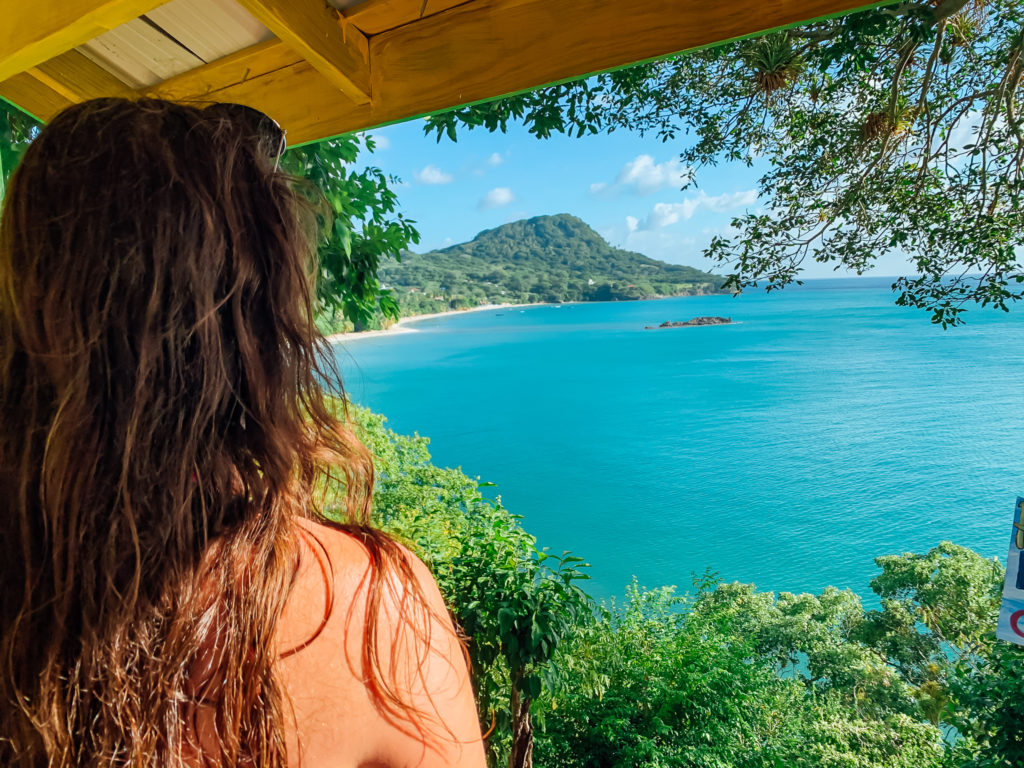Embark on an unforgettable journey to Peru, where ancient wonders, unique landscapes, and one of the world’s best cuisines await at every turn. Whether you’re cruising the mystical waters of Lake Titicaca, having a picnic in the desert or flying above the Nasca Lines, Peru offers many experiences that will leave you enchanted and inspired. Here are places you can’t miss in Peru:
Lima
Start your adventure in Lima, the vibrant heart of Peru, where ancient history meets modern chic! Picture yourself strolling along the bustling historic streets, sipping pisco sours with ocean views, and diving into a culinary wonderland that’s a foodie’s dream come true. From the lively streets of Miraflores to the historic charm of Barranco, Lima is ready to sweep you off your feet!
Neighbourhood Exploring
Make sure to carve out some time to visit the vibrant neighbourhoods of Lima. Dive into the bohemian atmosphere of Barranco, with its colourful street art, trendy cafes, and stunning ocean views from the iconic Bridge of Sighs. Wander through the historic streets of Miraflores, where lush parks, bustling markets, and world-class dining await around every corner. Plaza de Armas is a central hub in the heart of Lima. This main square is surrounded by iconic colonial architecture, the Lima Cathedral, and the Government Palace. Make sure to get your photo in front of the LIMA sign while you’re here. Spend some time getting lost in the beautiful cobblestone streets.
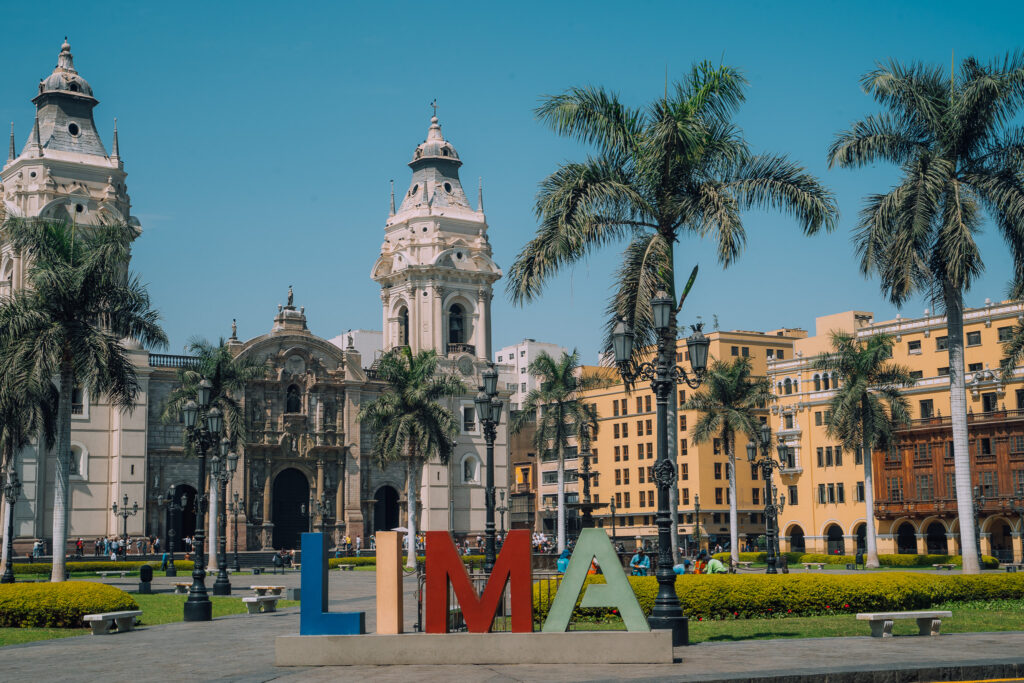
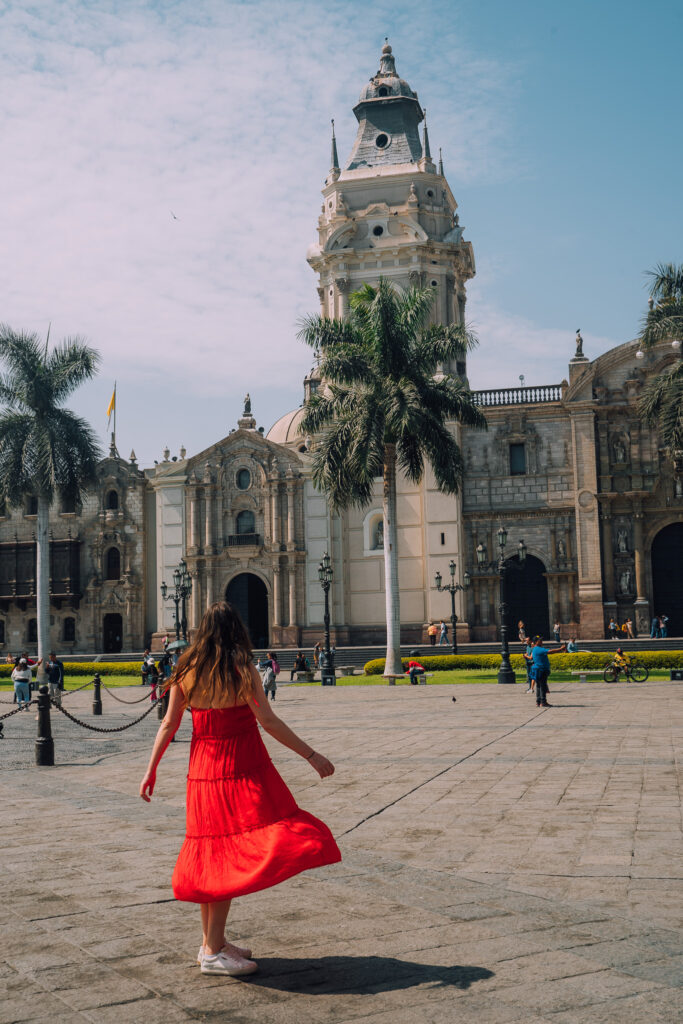
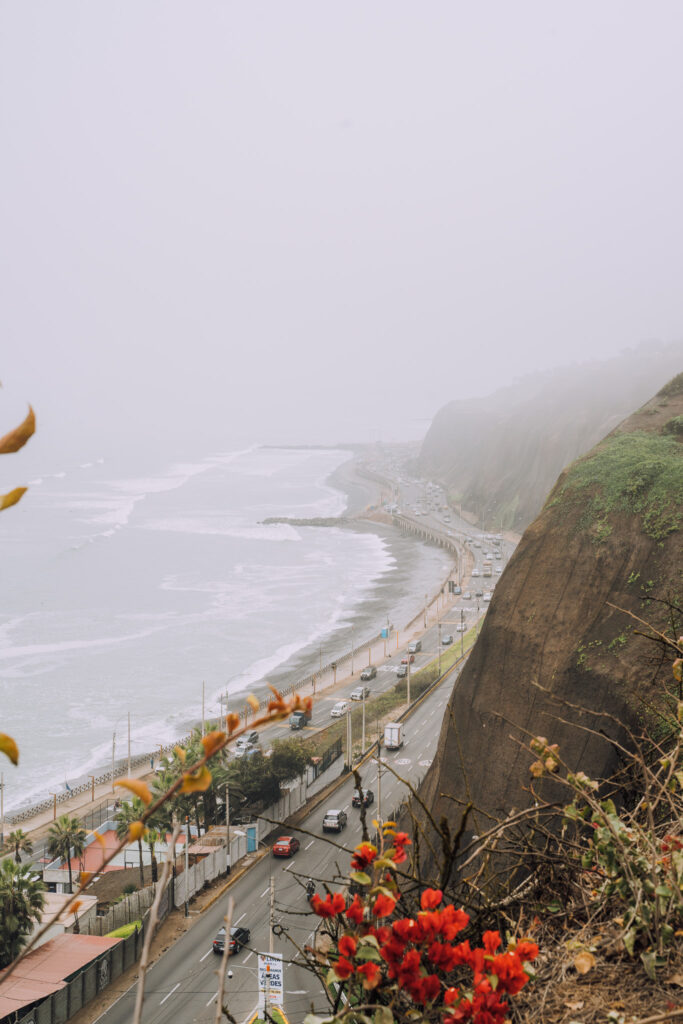
Learn about Peru’s History
- Casa de Aliaga: The stories they would tell if the walls of this building could talk. Casa de Aliagas is a stunning colonial mansion brimming with over 500 years of history, exquisite architecture, and enchanting tales of the past. Explore the house and admire the beautiful garden oasis inside.
- Larco Museum: Peru has a lot of ancient history, and Larco Museum is a fantastic place to learn about it. It has over 50,000 artifacts you can explore. They also have a beautiful garden terrace full of flowers and greenery, perfect for a bite after your museum visit.
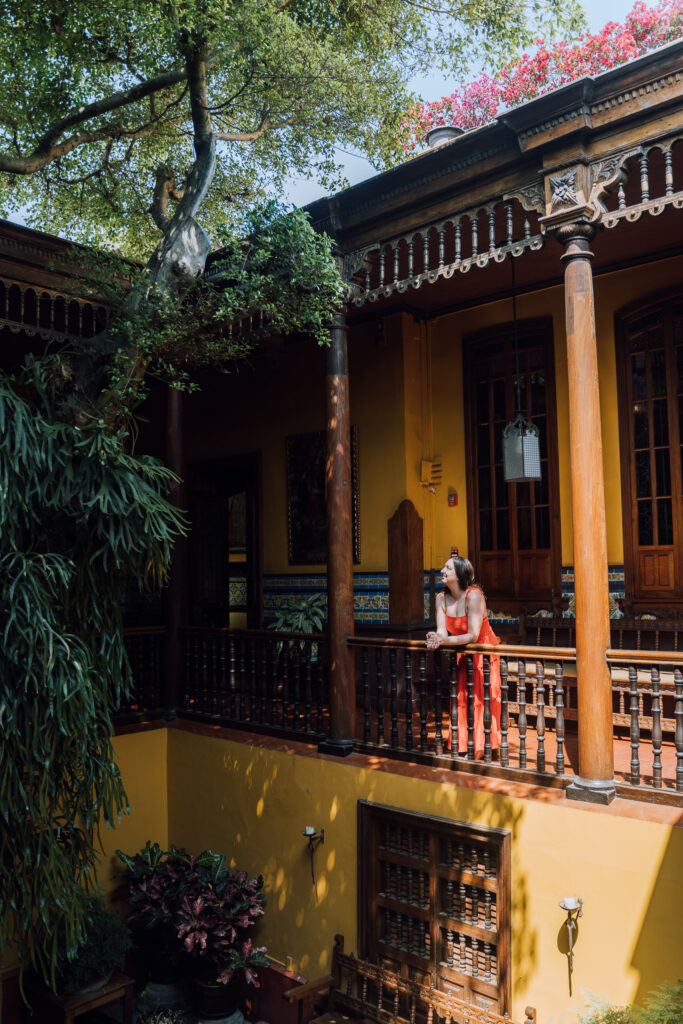
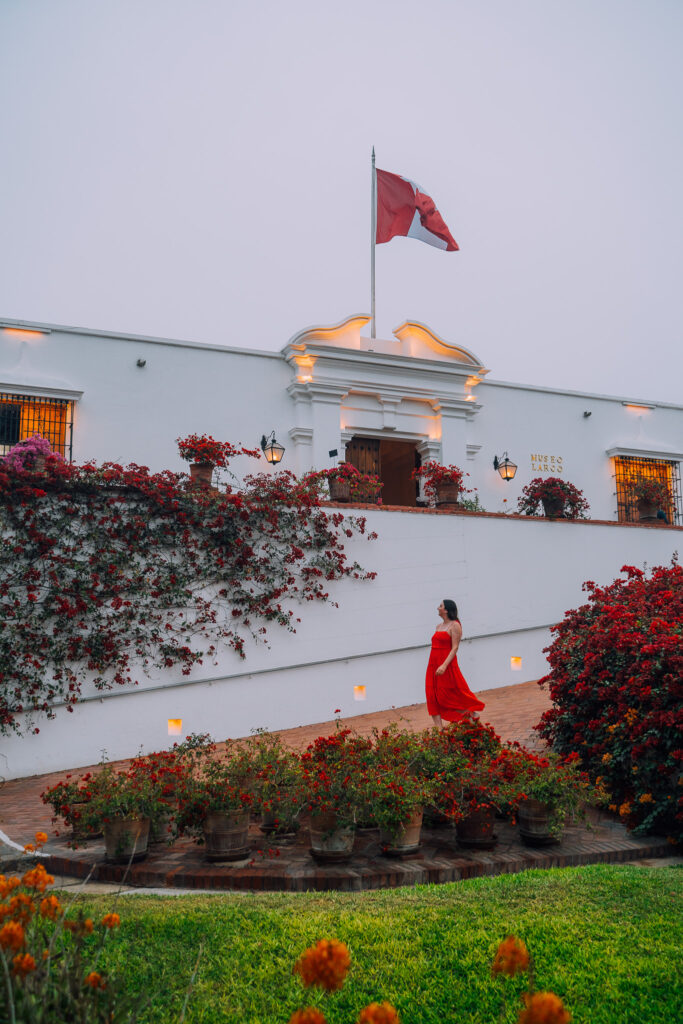
Dine at Some of the World’s Best Restaurants
Peru is home to some of the world’s best restaurants. Start your food journey in Lima. Mayta in Lima is one of the world’s top 50 best restaurants and won best restaurant at the World Culinary Awards. The service, presentation, and flavours are top-notch, so it’s no surprise why this restaurant tops the list. This place books up, so make sure to make a reservation in advance.
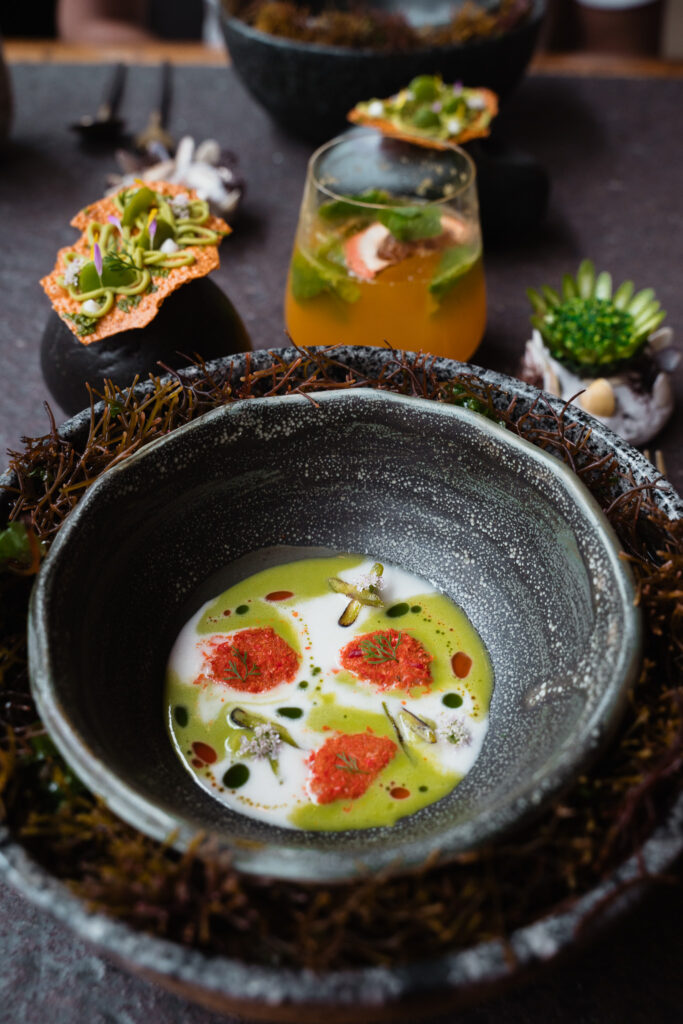
The name Mayta means where, what, and when. Their nine-course meal will take you through the different regions of Peru, from the coast to the Andean Mountains. Each dish is an innovative celebration of the region’s flavours. I love that we did this on the first day, not only as an incredible meal but also as a fun introduction to Peru through food.
Explore Lima’s Parks:
- Parque del Amor has beautiful coastal views where you can watch surfers catch a wave, but it’s also a park that celebrates love. The park was inaugurated on February 14, 1993. You’ll see lots of love locks and can add your own. This is also a popular spot for proposals.
- Parque Maria Reiche is perfect for an introduction to the Nasca lines, where you’ll see miniature lines illuminated at night.
Where to Stay in Lima
Miraflores Park Hotel is a luxurious stay in the heart of Miraflores, one of Lima’s most popular neighbourhoods. Enjoy a stay in their comfortable and spacious hotel rooms with lots of little touches for your stay, like slippers and treats. I loved the elegant front lobby with its grand bookshelves and lobby bar. Enjoy their pool overlooking the coast on a sunny day. They have an excellent breakfast buffet, from professional pastries to Peruvian specialties.
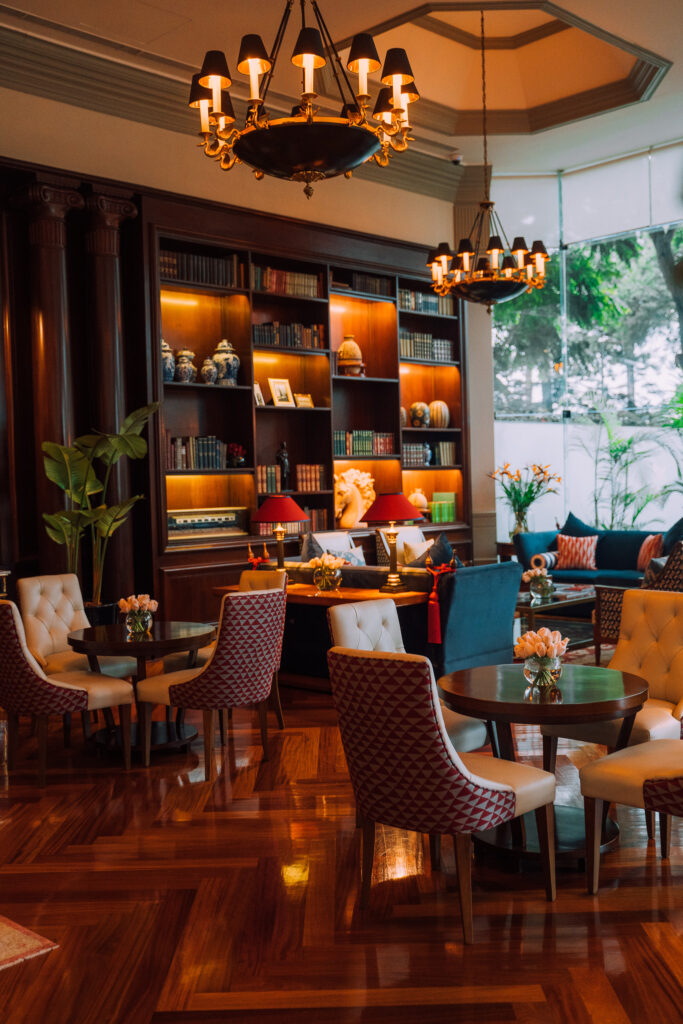
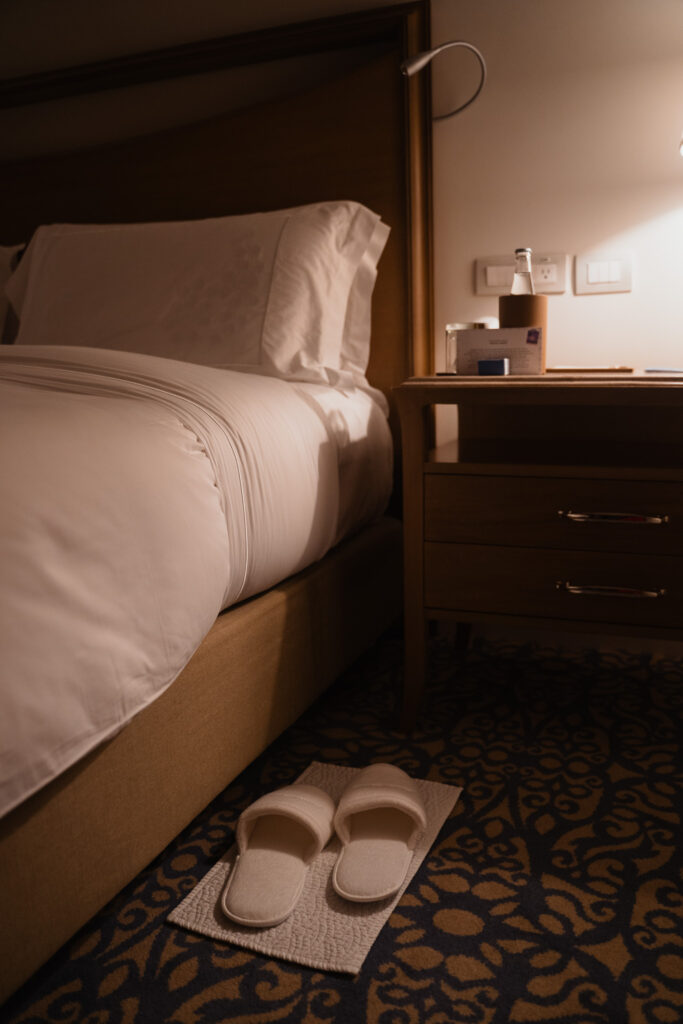
Pisco
Nasca Lines
The Nasca Lines are a series of giant, ancient geoglyphs etched into the desert plains of southern Peru. Created by the Nasca culture between 500 BCE and 500 CE, these lines form various shapes and are only visible from the air. Some figures include a monkey, astronaut, hummingbird, spiral and more. Why they exist is still a mystery, but there are theories related to religion and astronomy. Take a flight to see these mysterious lines in person. I loved seeing the monkey, spiral and astronaut!
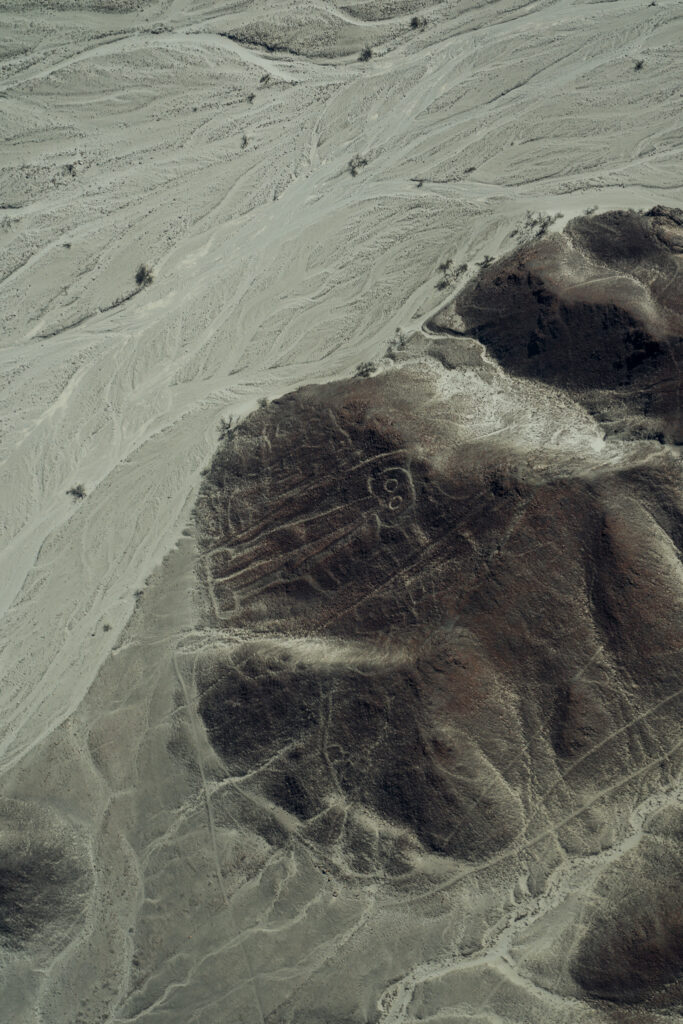
The pilots are skilled at maneuvering so that both sides of the plane see all the figures. If you get motion sickness like me, here are some tips before you take the flight: take Gravol, choose a point in the plane to center yourself when you aren’t looking out the window, and listen to when the pilots indicate the figure you will be out your window to save time looking out the window/your phone.
Ica
Tacama Winery
A visit to Tacama Winery, Peru’s oldest vineyard, offers an enchanting blend of history, culture, and fine winemaking. Nestled in the scenic Ica Valley, Tacoma boasts a heritage dating back to the 16th century, making it a must-see for history enthusiasts and wine lovers alike.
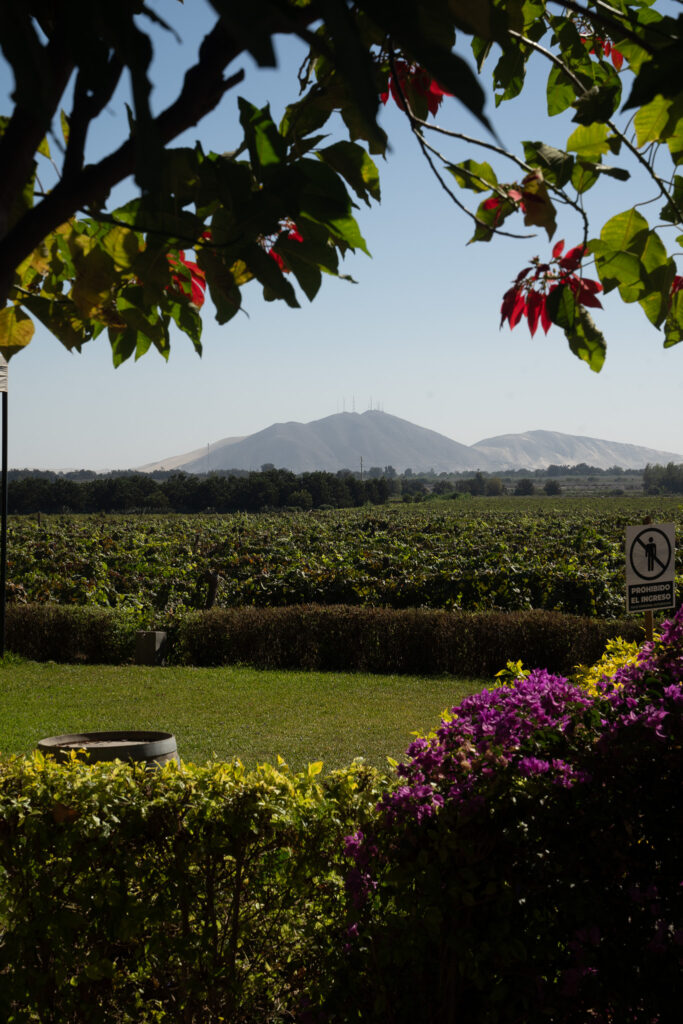
The winery was initially started as an experiment to make wine in the desert instead of importing wine from Europe. The Ica Valley became a thriving environment to create wine, and Tacama Winery was the first vineyard in South America. The vineyard’s legacy is preserved today, and you can tour the beautiful colonial-style estate, learn about the traditional and modern winemaking processes, and indulge in tastings of their renowned wines and piscos. The winery’s picturesque setting, rich legacy, and delightful culinary offerings make Tacama a unique and unforgettable destination.
Huacachina
Huacachina is an oasis in the middle of the desert. Seeing this tiny village nestled among towering dunes and centered around a tranquil, emerald lagoon almost seems like a mirage! Enjoy an afternoon exploring this little village and walking around the lagoon. I also recommend heading up the dunes for an incredible vantage point of Huacachina from above.
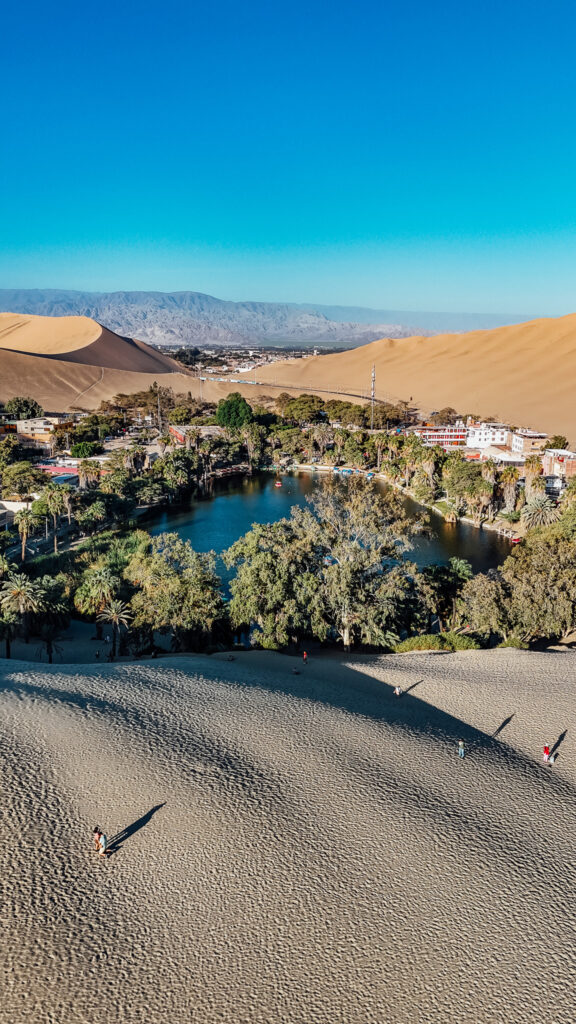
You’ll see many people enjoying adventures in the sand, but wait for those in the next destination, Paracas.
Paracas
Embark on a thrilling desert adventure in Paracas with Adrena Arena, a highlight of our trip. Begin your journey with an exhilarating dune buggy ride during the golden hour. Your skilled driver will expertly navigate the sand, providing a heart-pounding experience as you accelerate up and down the dunes.
Next, you’ll find the perfect spot for sandboarding! My fear of heights made me nervous for the first run, but it quickly faded. I had a blast and couldn’t wait to go again.
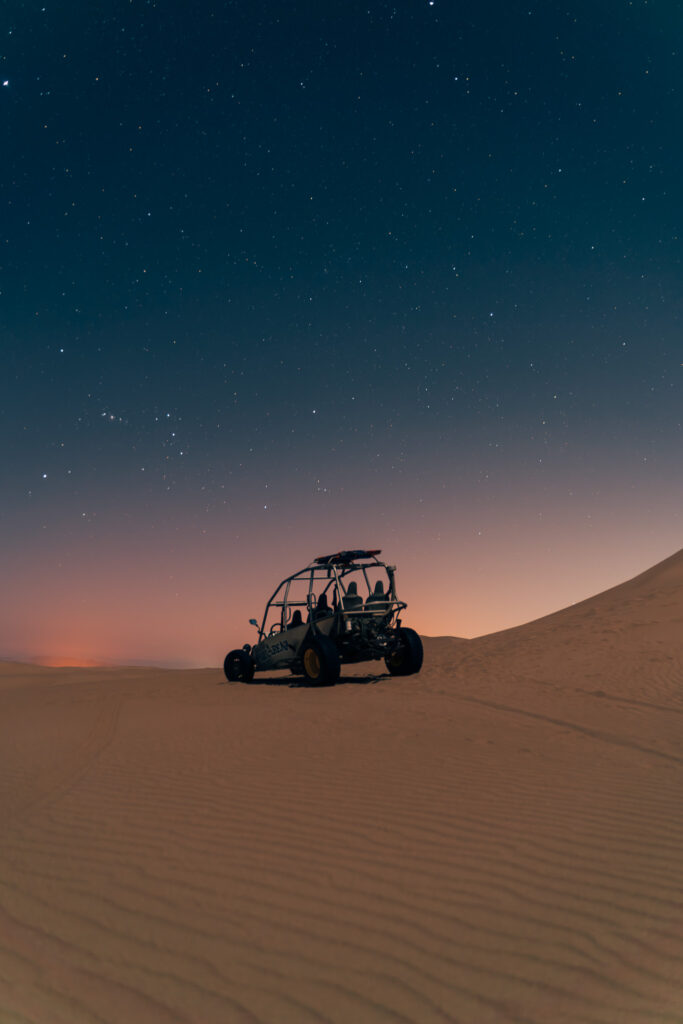
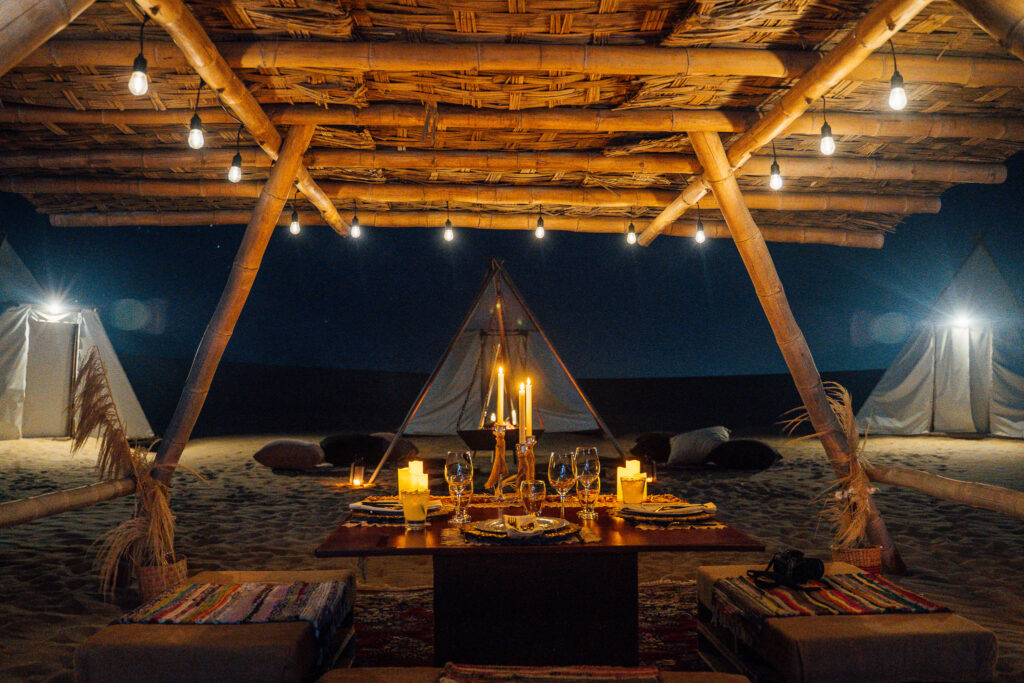
Cap off the night with dinner in the middle of the desert. This was such a magical evening as we dined under the stars. Everything was perfect, from the bonfire pit to the charcuterie to the barbeque. This enchanting location is a popular spot for proposals, and it’s easy to see why. Additionally, going glamping here would be a fantastic experience, waking up to the sunrise amidst the dunes.
Arequipa
A city not to be missed is Arequipa, Peru’s dazzling white city known for its charming colonial architecture made from white volcanic stone. Volcanoes, both active and dormant, surround Arequipa. Not only is it beautiful, but it’s also an excellent spot to get acclimatized at 2300m above sea level. Our guide, Kaitlin, said Arequipa has Lima’s modernity and Cusco’s quiet.
Explore Downtown Arequipa
The historic center of Arequipa was designated a UNESCO World Heritage Site in 2000, and it is recognized for its well-preserved colonial architecture. Start your adventure at the Plaza de Armas, surrounded by stunning colonial architecture and the majestic Basilica Cathedral. Wander through the bustling streets with charming cafes, artisan shops, and colourful markets. If you’re looking for souvenirs, head to Casino Flores Del Campo. You’ll find great prices on everything from tiny alpaca stuffed animals to hats. I loved getting lost in Arequipa’s cobblestone streets and enjoying the views.
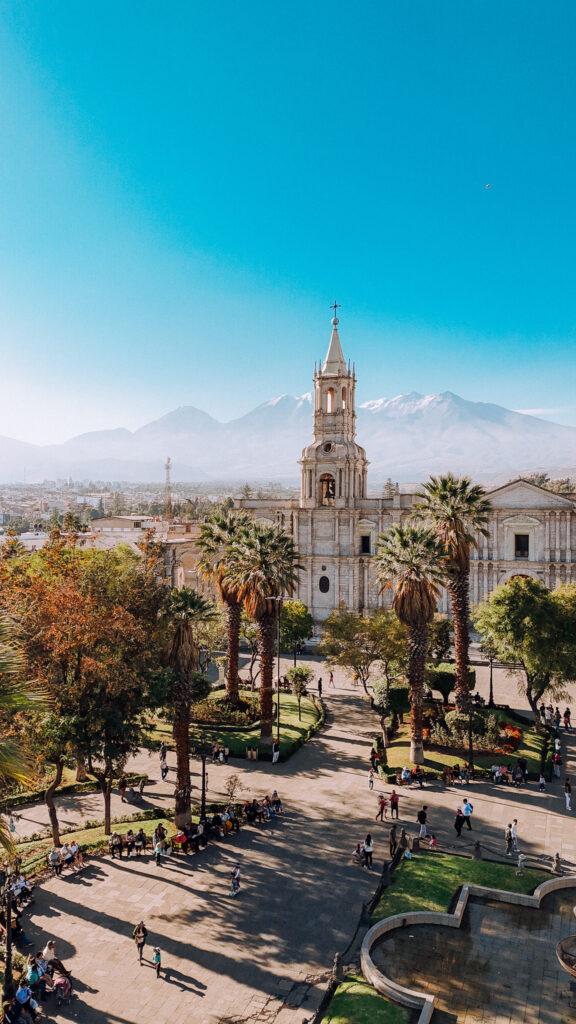
Santa Catalina Monastery
Visiting the Santa Catalina Monastery is like stepping into a vibrant, centuries-old Spanish city nestled within the heart of Arequipa. This sprawling, vividly painted complex offers a serene escape with its beautiful courtyards, ornate chapels, and historic living quarters, all impeccably preserved. Exploring its labyrinthine streets and hidden corners provides a unique glimpse into the lives of the nuns who once resided there. You won’t want to miss a captivating journey through history and architecture.
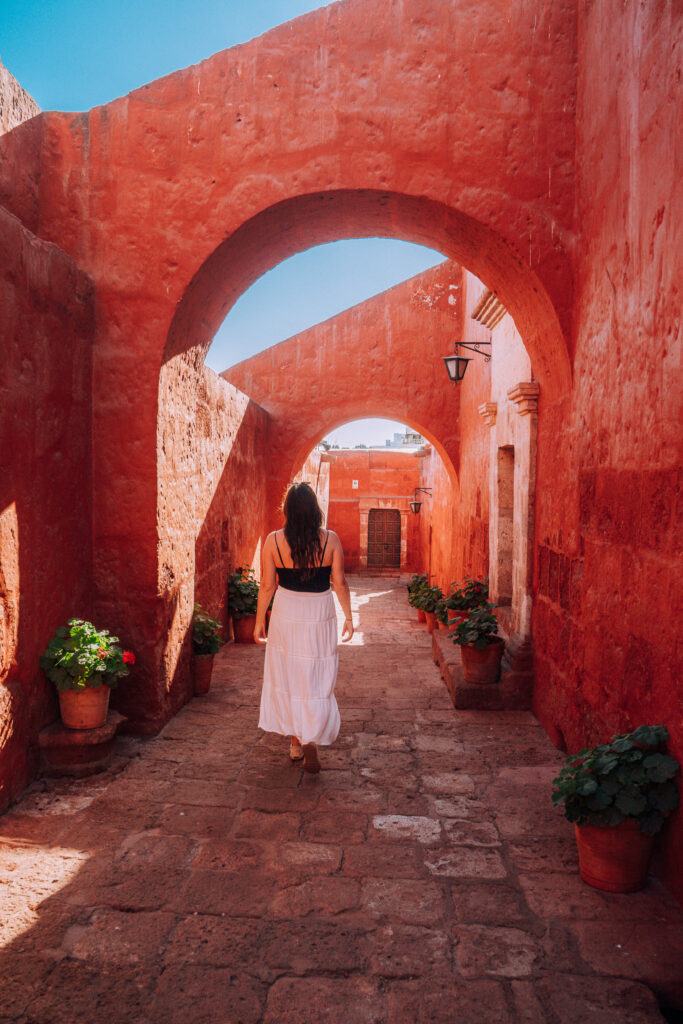
Founded in 1579, the monastery is one of Peru’s oldest and most significant religious sites. It was initially intended to house nuns from wealthy Spanish families. It’s often described as a “city within a city,” featuring its streets, plazas, and living quarters, creating a self-contained world.
Take your time winding through the colourful buildings, and go to the rooftop to see a view of the volcanoes in the distance.
Sunset in Arequipa
- Mirador de Carmen Alto has a beautiful lookout over the volcanoes and surrounding farmland. It is a great spot to have a drink and enjoy the hammocks or lounge areas.
- Mirador de Yanahuara offers an Instagram-worthy view of Misti Volcano and Arequipa framed by these famous arches. Join locals as you watch the sunset at this popular viewpoint.
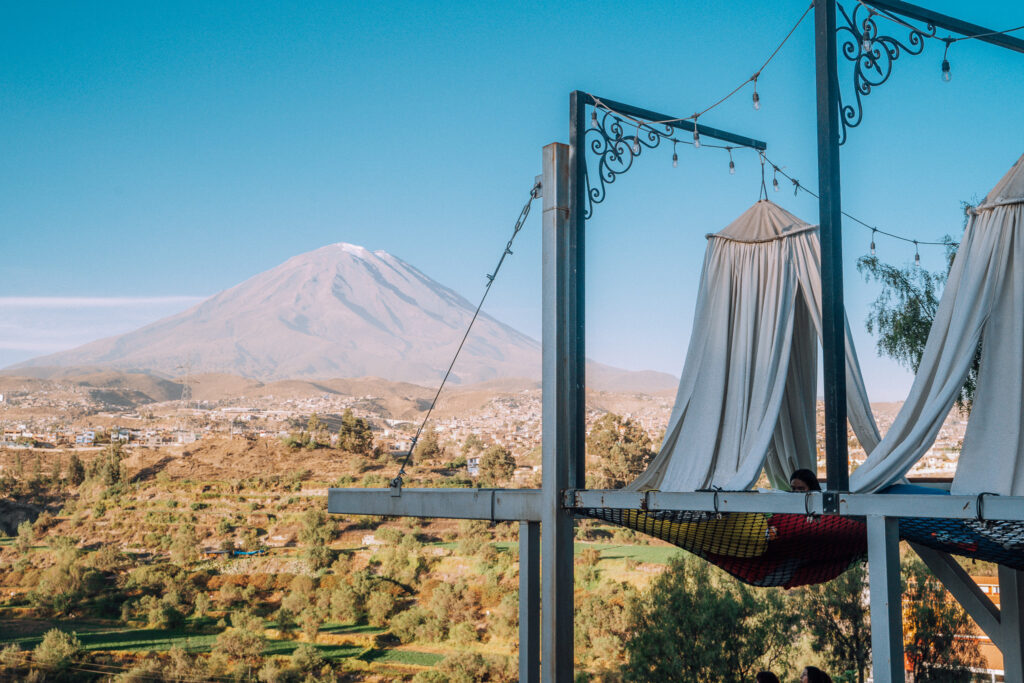
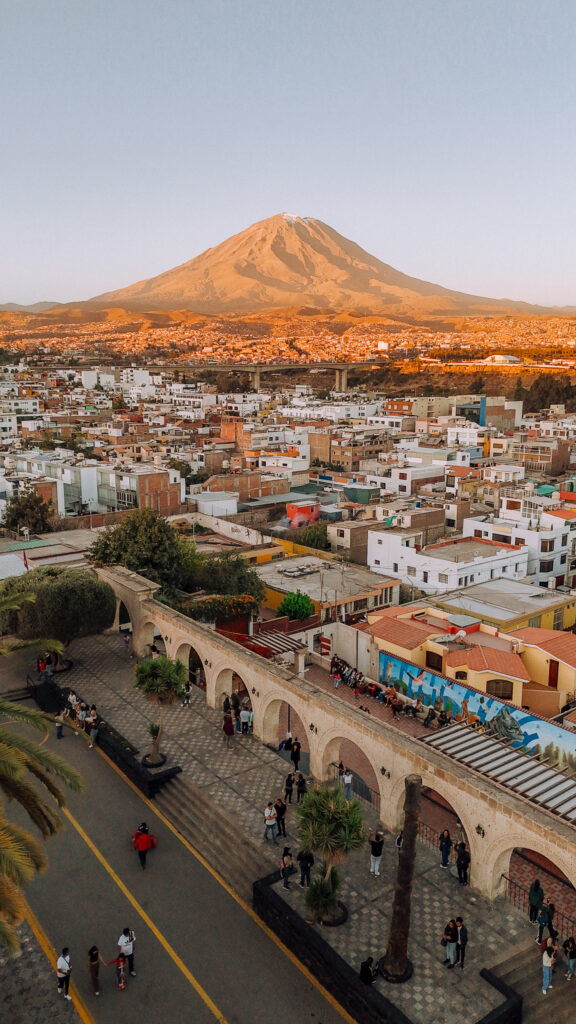
Dining in Arequipa
Did you know that UNESCO named Arequipa a Creative City for Gastronomy in 2019? The surrounding landscape with fertile volcanoes makes it an excellent location for produce, and there is a strong focus on local ingredients in Arequipa. Here are two foodie finds to try in Arequipa:
- Nestled in a charming building, Chicha is a culinary hotspot that captures the essence of Peruvian flavour with a contemporary twist. It is owned by Peruvian Chef Gastón Acurio, who is also the ambassador of Peruvian cuisine.
- Zig Zag Restaurant connects the Alps with the Andes with their mix of Swiss and Peruvian cuisine. It Zag is famed for its innovative use of Andean ingredients, particularly its sizzling volcanic stone-cooked meats and fresh seafood dishes. I went with the volcanic stone-cooked meats and tried beef, llama and chicken with local sauces.
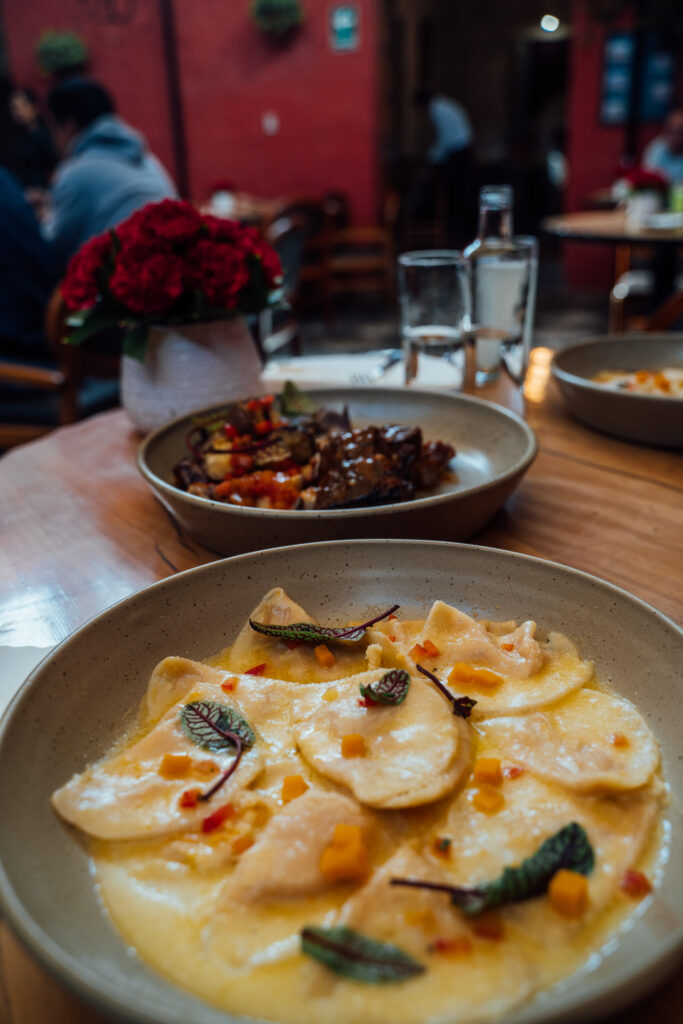
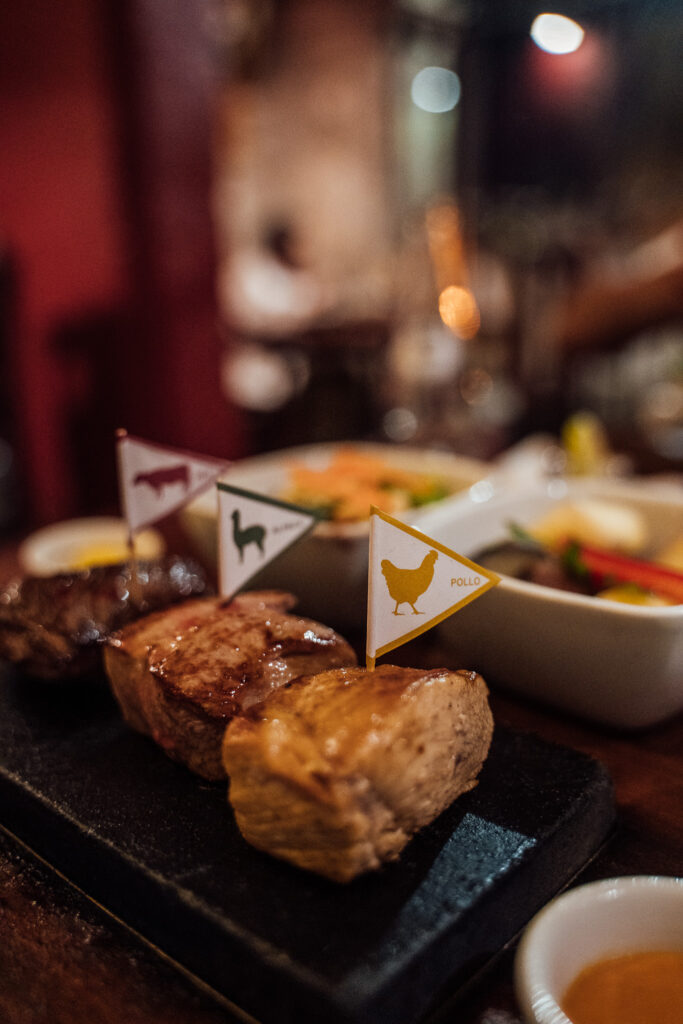
Where to Stay in Arequipa
Hampton by Hilton blends tradition with modernity with their central hotel in Arequipa. The main lobby and restaurant is a preserved historic building made from volcanic stone. The rooms are modern and comfortable, and you’ll be steps from the main square, restaurants and Arequipa attractions.
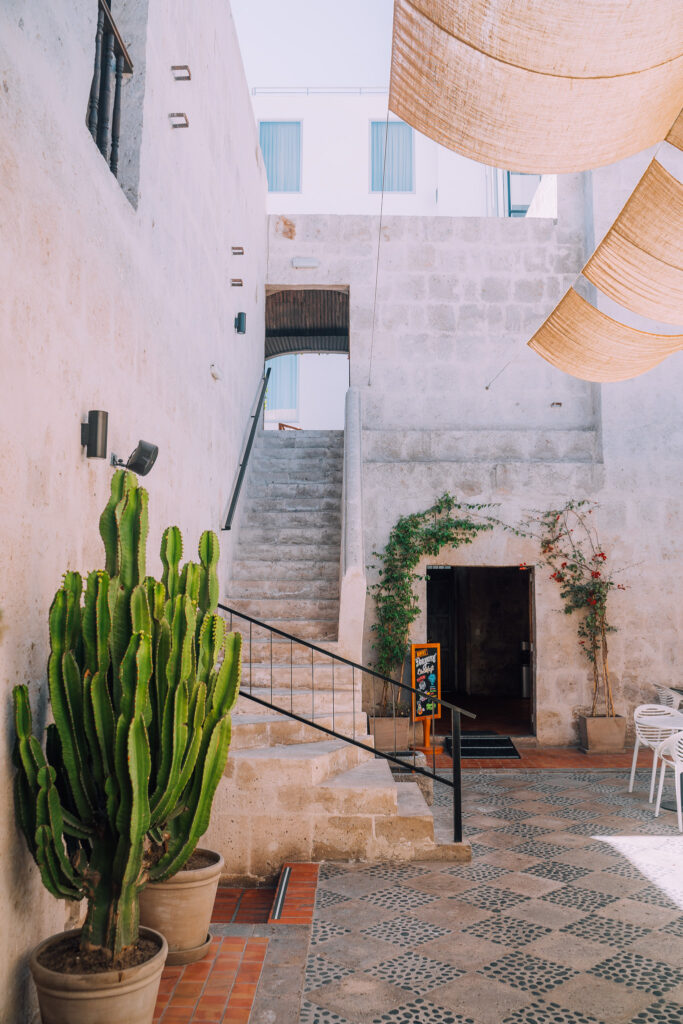
Colca Valley
Colca Valley is a hidden gem in southern Peru that promises an unforgettable adventure! This stunning region is renowned for its dramatic landscapes, with one of the world’s deepest canyons, terraced agriculture that dates back to pre-Inca times, and charming, traditional villages. Whether you’re seeking heart-pounding outdoor activities or serene natural beauty, the Colca Valley is a must-visit destination that will captivate your senses.
Reserve of Pampas Cañahuas
We drove about three hours from Arequipa to Colca Valley. On the way, we passed through the Reserve of Pampas Cañahuas, the perfect place to see vicuñas. With the help of the reserve and special protections, the population of vicunas has reached over 300k in Peru. We learned that the Incas wore clothes made from vicuña fibres. They would catch them and then let them go.
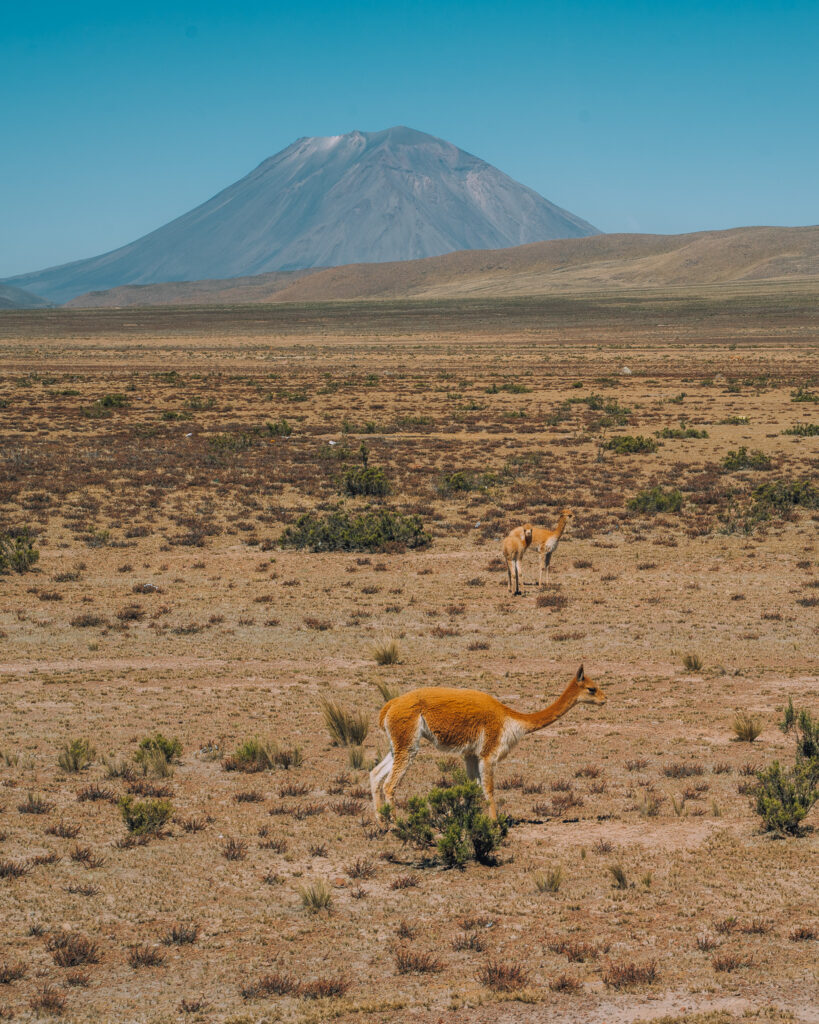
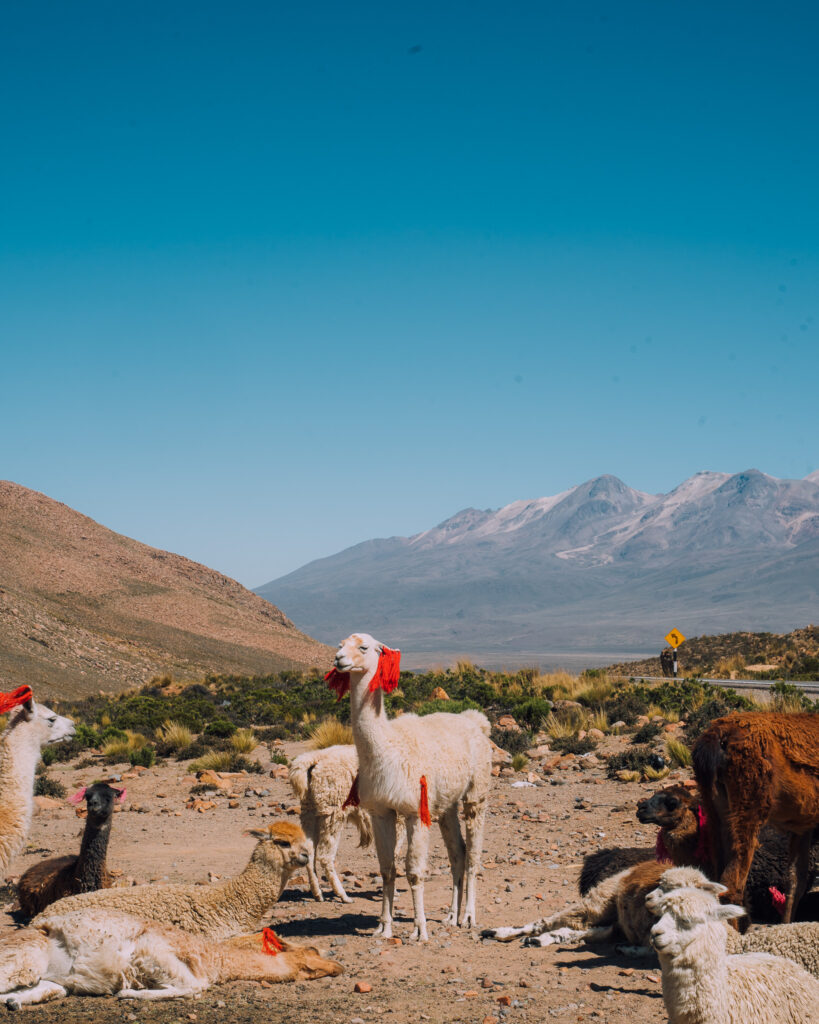
These adorable relatives of the llama can be spotted plenty as you drive through. Keep your camera out because you’ll also find llamas and alpacas along the way!
Cruz del Condor
Colca Canyon is one of the deepest canyons in the world — nearly 14,000 feet from its highest point to its lowest (the second deepest in the world) — and it’s home to the Andean condor, a sacred bird in Incan culture. Cruz del Condor is a fantastic viewpoint to see the wild Andean Condor gliding through the air. If we were lucky, I expected to see one or two, but we probably saw closer to 20. We were so fortunate with the amount we saw and how close they came as they flew back and forth! Nothing will prepare you for seeing this mighty bird with the backdrop of the canyon. Our Guide, Mauricio, shared many cool facts about the condors and region with us and showed us some other incredible viewpoints.
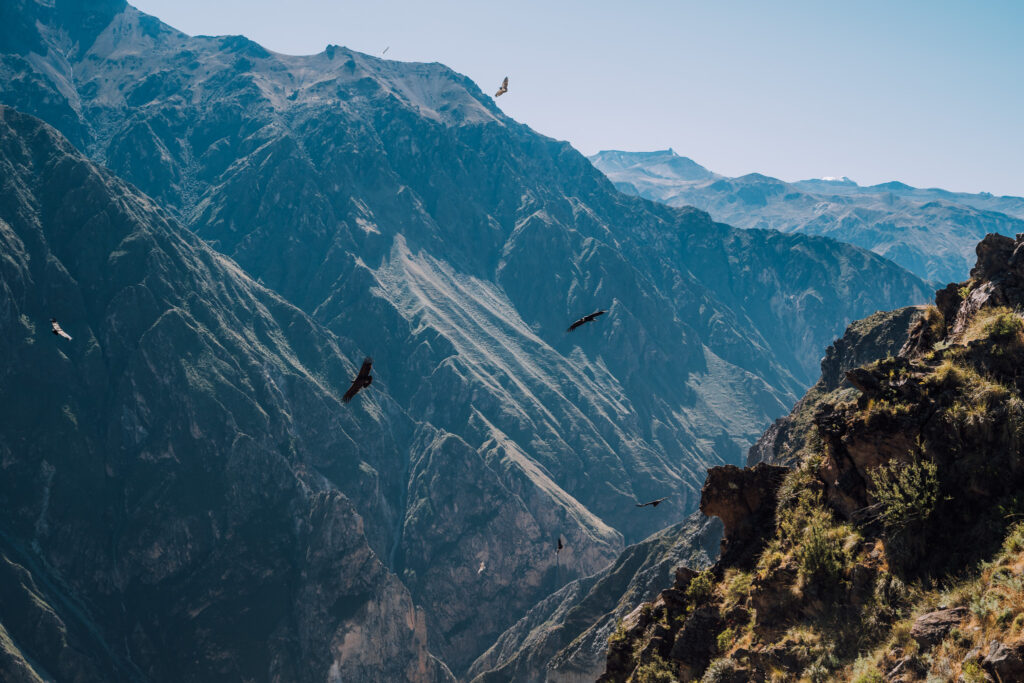
Trek Uyo Uyo
Uyo Uyo is an archaeological site in Colca Valley brimming with mystery and wonder. The trek begins with a scenic hike through lush Andean landscapes, passing terraced fields and picturesque villages. As you ascend to Uyo Uyo, you’ll discover the remnants of an ancient Inca settlement, including stone structures, ceremonial platforms, and agricultural terraces, all set against breathtaking mountain vistas.
Where to Stay in Colca Valley
Puqio Andean
Stay at Puqio, where luxury meets nature. It provides a unique opportunity to immerse yourself in the tranquillity and natural beauty of Colca Valley. You’ll be nestled into Colca Valley and treated to incredible views from your room, including the valley and even volcanoes off in the distance. The hospitality at this hotel is impeccable, and so many little touches tie into this unique location, from poems in the room to eucalyptus hanging in the shower. I loved every moment of this serene retreat and soaking up the surrounding views.
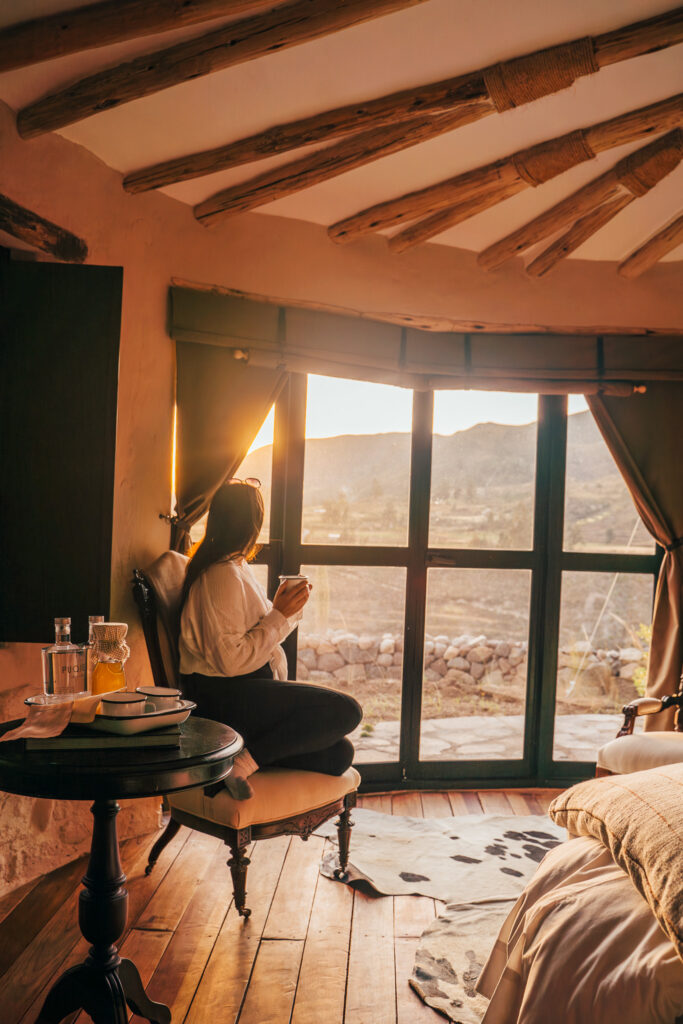
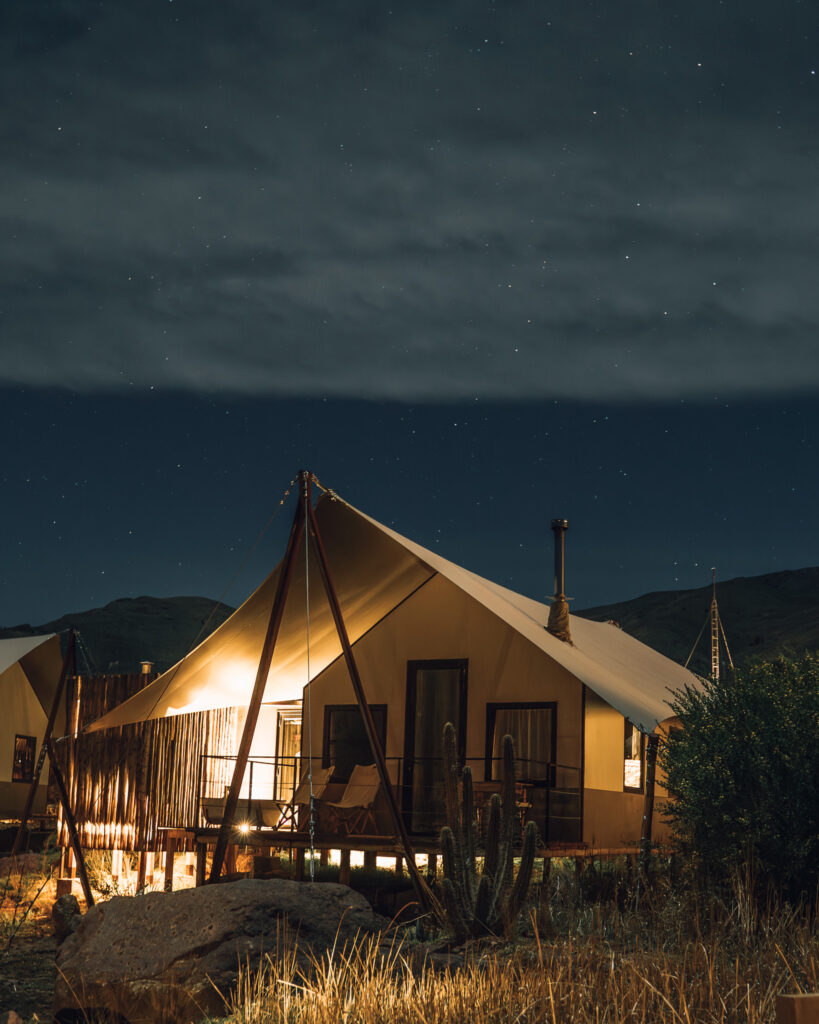
The rooms’ design gives a comforting, glamping feel while still being a luxury hotel room. They prepared a fire in our room each night to make it nice and cozy for bed.
All meals and excursions are included. Meals are baked in their clay oven and served buffet style so that you can try each of the day’s specialties. At Puqio, we had the opportunity to participate in Pachamanca, an ancient Andean tradition. This unique culinary experience involves cooking your meal underground with hot stones, a practice believed to offer respect to Mother Earth in Incan culture.
TIP: This was the first place I felt the altitude in Peru, so we took some time to relax and acclimatize. Listen to your body and go slower if you are feeling the altitude. Locals recommend coca and muña tea to help as well, so I had that at most meals. You can also get pills to help. After a good night’s sleep and a few minutes of oxygen from the hotel, I was feeling much better.
Lake Titicaca
Lake Titicaca is the world’s largest navigable lake at 3800m above sea level. Lake Titicaca means “great puma.” The lake got its name because it somewhat resembles the shape of a puma, and pumas could also be found drinking from the lake in ancient times. You’ll find 60% of the Lake in Peru and 40% in Bolivia. It’s said that Lake Titicaca might be the first place where the Incas came from and that they are some of the people are some of the last Incan descendants. In 1968, there was a temple found underwater.
In 1977, they found that all the Inca temples were built 45 degrees to the equator line from north to south. On the day of the sun/winter solstice, the Milky Way is over that diameter, and it said Lake Titicaca gets its energy.
Taquile Island
Taquile Island has a population of 2,200 and is known for its colourful textile art. Explore the island and witness the local life, traditional outfits, and way of life. Taquile has no police, but it does have a city hall. Our guide, Alberth, pointed out how hats can indicate if someone is a city official and marital status.
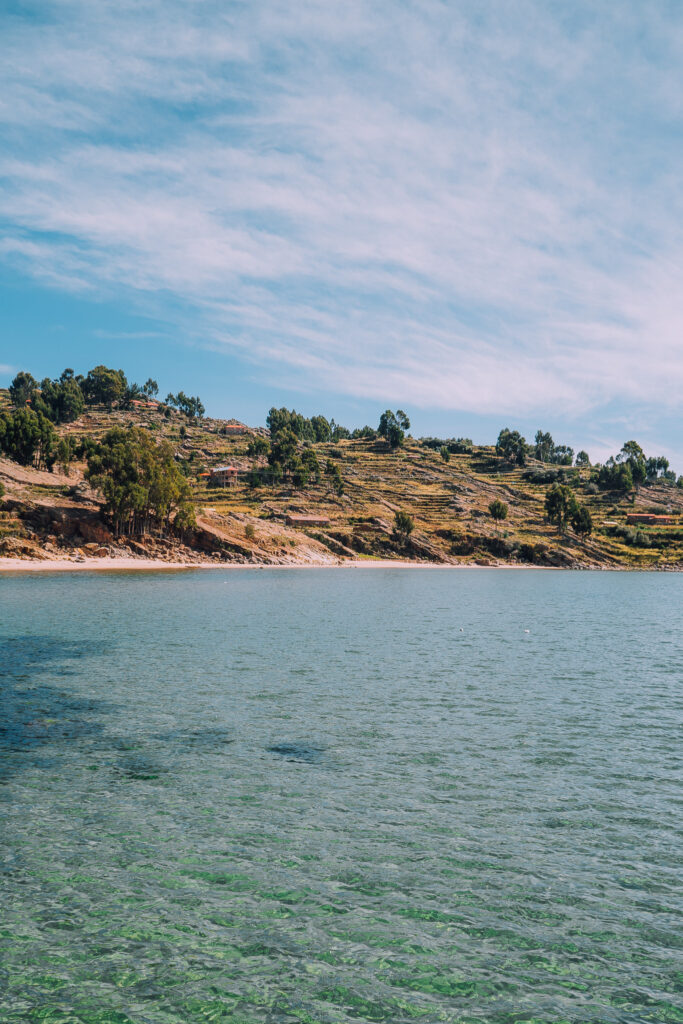
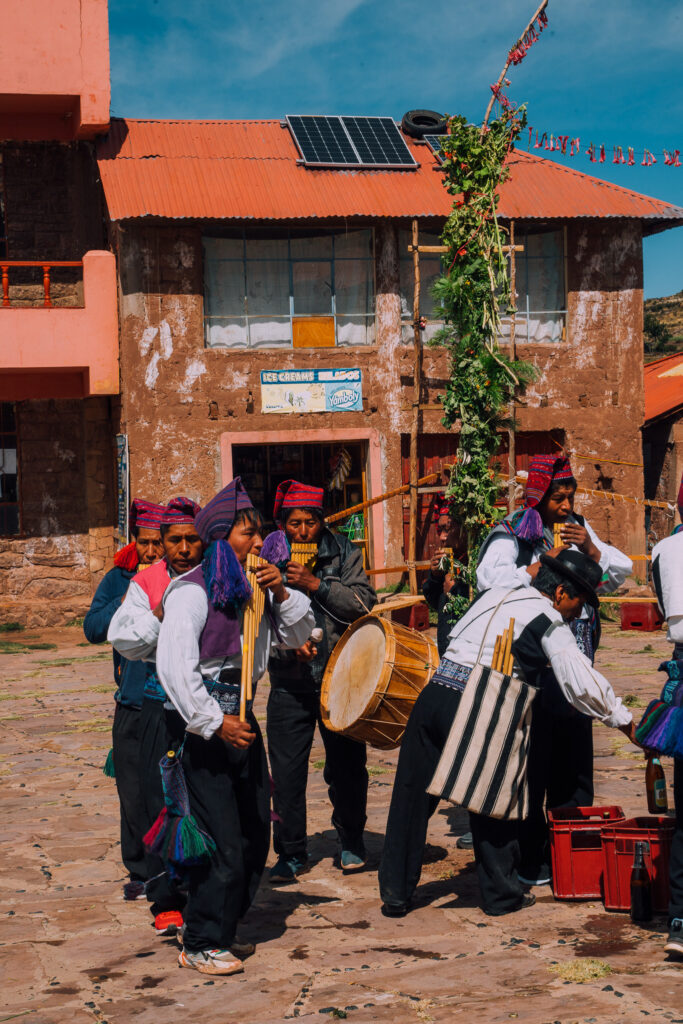
We visited during Fiesta de la Vía Láctea (Festival of the Milky Way). This festival is deeply rooted in the islanders’ cultural and spiritual traditions, reflecting their reverence for the cosmos.
We could see some celebrations, including performances in the town square. One of the men kindly came over, welcomed us, and invited us to the celebrations. They speak the local dialect, Puno Quechua, so our guide, Alberth, translated between us.
Uros Islands
The Uros Islands are a group of islands made of Totora Reeds on Lake Titicaca. There are approximately 1,300 inhabitants across 100 islands. The Uros people fled to the reeds centuries ago for a safe place from the Incas. We visited Uros Totino, where the locals showed us how they maintain their way of life by building homes, boats, and maintaining the island with Totora Reeds.
You can visit this island as a guest of Titilaka Sunset because they help support the island.
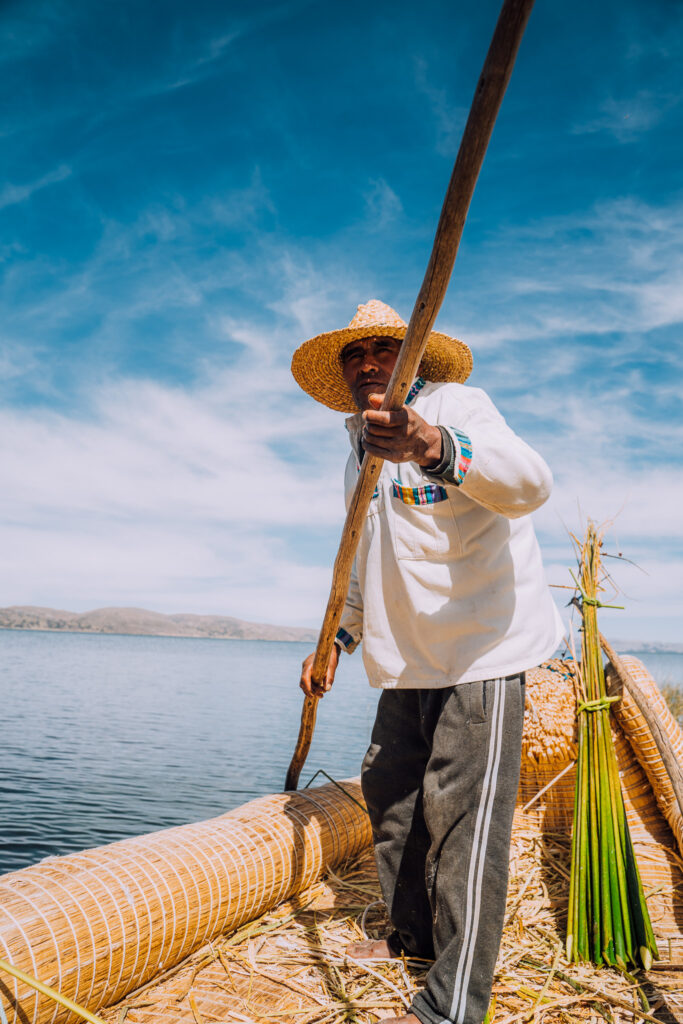
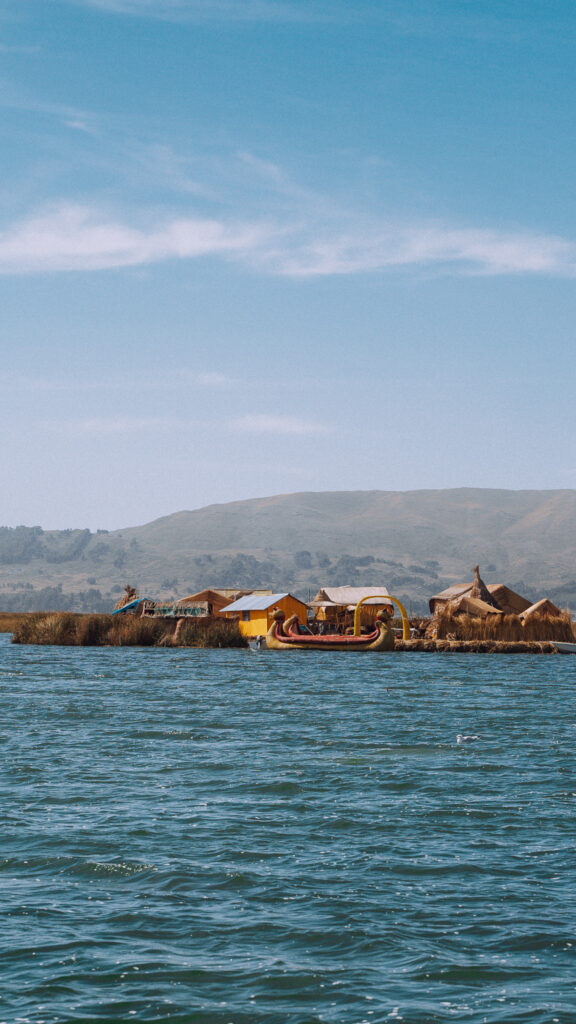
Where to Stay at Lake Titicaca
Titilaka
Staying at Titilaka offers a luxury retreat amidst the stunning landscapes of Lake Titicaca. This exclusive lodge combines modern comfort with traditional Andean hospitality, providing guests with an unforgettable experience of tranquillity and relaxation. Enjoy small moments like their golden hour bonfire or unwinding in their hot tub with water views.
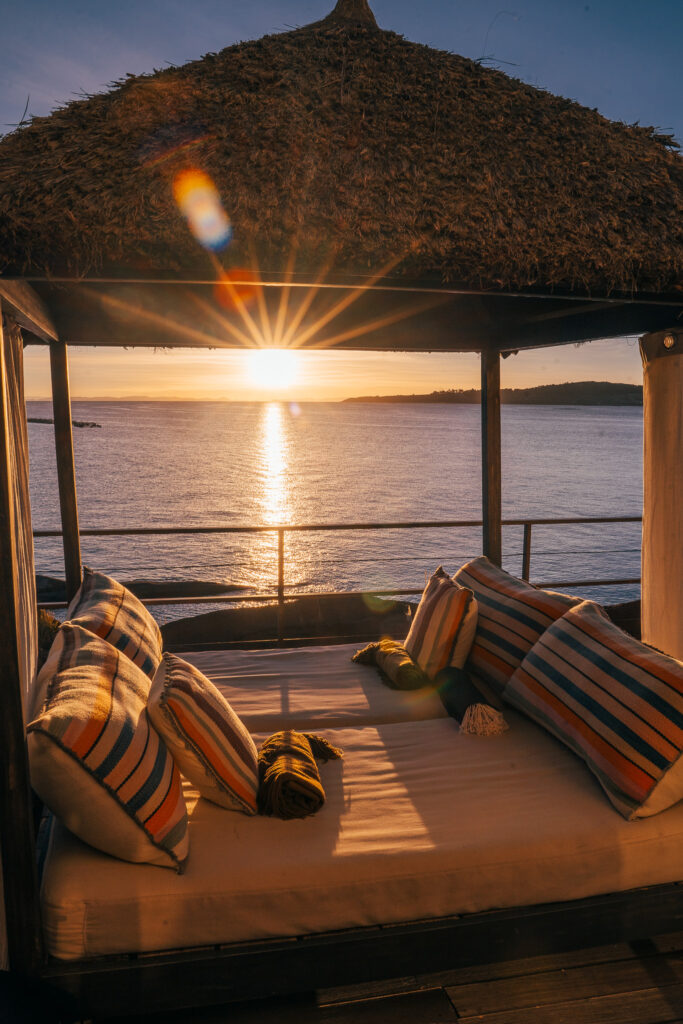
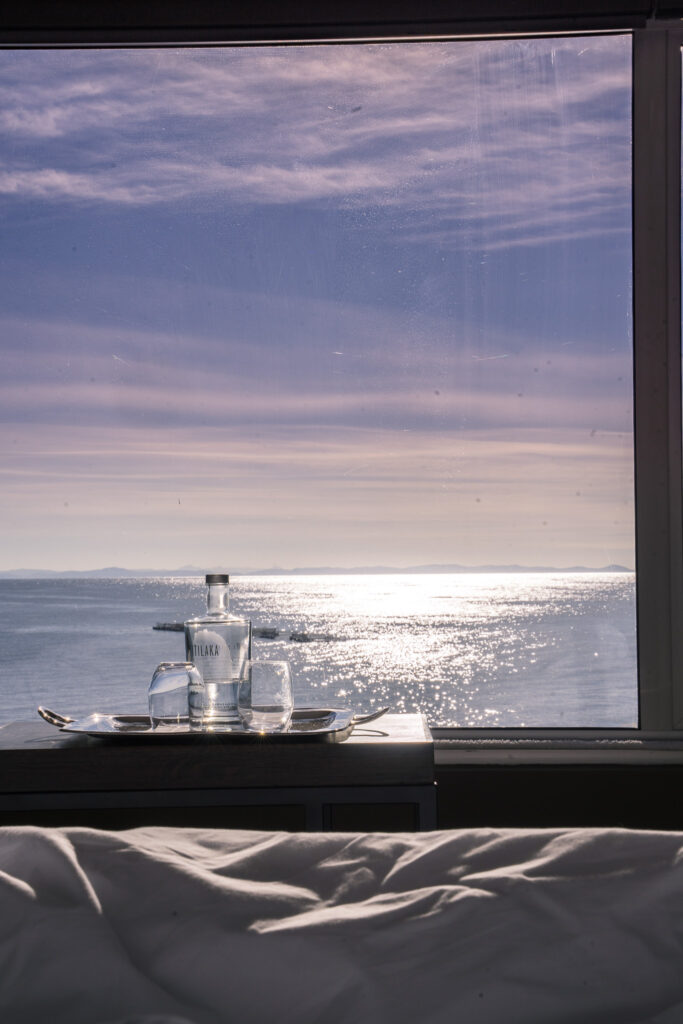
Enjoy gourmet cuisine made from local ingredients in their stunning dining room. I couldn’t resist getting their ceviche made from Lake Titicaca trout.
This hotel has a stunning golden hour, and you won’t want to miss the sunrise! You can even get incredible lake views right from your bed. Titilaka is a dreamy stay matched with stunning views.
Thank you to Prom Perú Canada for sponsoring this post. As always, all thoughts and opinions are my own. I hope you have as much fun exploring Peru as I did. I’d love to see your adventures. Feel free to tag me on Instagram and TikTok.
